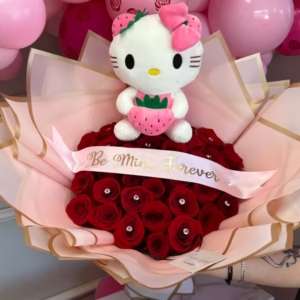The Enduring Legacy of Boo Boo Kitty: A Pop Culture Icon and Symbol of Nostalgia
Boo Boo Kitty, a character name that evokes smiles and curiosity, has an enduring place in pop culture, cementing its reputation as both an inside joke and a nostalgic symbol for fans of certain television series and movies. The name “Boo Boo Kitty” is most widely recognized from its appearance in the classic 1970s sitcom Laverne & Shirley, where it was the name of Shirley Feeney’s stuffed cat. But beyond its television roots, Boo Boo Kitty has grown into something much more: a cultural touchstone that represents a variety of sentiments from childhood comfort to kitsch humor. Over the years, Boo Boo Kitty has taken on new meanings, evolving into a reference point across different generations.
In this article, we will take a deep dive into the history and significance of Boo Boo Kitty. From its origins in Laverne & Shirley, through its impact on fans, and its appearance in modern media, Boo Boo Kitty represents a piece of television history that has far outlasted its initial run. We will also explore how the character’s name has been repurposed, revived, and reimagined in different contexts, proving that Boo Boo Kitty remains as charming and relevant as ever.
Boo Boo Kitty’s Origins: Laverne & Shirley
To understand the cultural significance of Boo Boo Kitty, we must first travel back to the late 1970s, when the sitcom Laverne & Shirley was at its peak. Created by Garry Marshall, the show followed the lives of two single women, Laverne DeFazio (played by Penny Marshall) and Shirley Feeney (played by Cindy Williams), as they navigated the ups and downs of working-class life in Milwaukee during the 1950s and 1960s. The series, which was a spin-off of Happy Days, became immensely popular for its humorous take on friendship, work, and the challenges of young adulthood.
Shirley Feeney, one half of the titular duo, was the more optimistic and idealistic character compared to her best friend Laverne. Shirley was known for her feminine demeanor, whimsical outlook, and her quirky attachments to her stuffed animal, Boo Boo Kitty. Boo Boo Kitty was not just a toy but a comfort object that represented Shirley’s childlike innocence and need for security. This black stuffed cat with big eyes was often seen perched on Shirley’s bed or being held close during moments of distress or uncertainty.
The introduction of Boo Boo Kitty into the show was a clever way to showcase Shirley’s vulnerability and softer side, offering a contrast to Laverne’s tough exterior. The toy became a recurring element in the show, used for both comedic and emotional effect. Fans of Laverne & Shirley quickly came to associate Boo Boo Kitty with the quirky but lovable Shirley. In this way, Boo Boo Kitty wasn’t just an inanimate object; it became a part of Shirley’s identity, representing her youthful spirit and emotional depth.
Boo Boo Kitty and Its Symbolism in Laverne & Shirley
Beyond its role as a mere stuffed animal, Boo Boo Kitty served as a symbol of Shirley’s innocence and emotional security. Shirley, though an adult living on her own, was depicted as someone who still cherished the comfort that childhood toys provided. In the sometimes harsh and unpredictable world that Laverne and Shirley navigated, Boo Boo Kitty was Shirley’s anchor to a simpler, more comforting time.
The inclusion of Boo Boo Kitty also added to the characterization of Shirley as someone who embraced her quirks and had no qualms about holding on to a stuffed animal well into adulthood. It was a subtle but significant message about authenticity, particularly for women, who were often portrayed in media as having to choose between adulthood and maintaining ties to childhood comforts. Shirley, in her earnestness, defied these conventions, and Boo Boo Kitty became emblematic of her ability to balance the realities of adulthood with her intrinsic need for comfort and reassurance.
Moreover, Boo Boo Kitty’s presence in the show contributed to the overall comedic dynamic of Laverne & Shirley. Its frequent appearances often accompanied moments of slapstick comedy or emotional vulnerability, providing both humor and tenderness in equal measure. While Boo Boo Kitty was not a speaking character, it became a central part of the show’s world, and fans embraced it as much as they did the human characters.
Boo Boo Kitty and Fan Culture
As Laverne & Shirley became a cultural phenomenon in the late 1970s and early 1980s, Boo Boo Kitty took on a life of its own. Fans of the show began to celebrate Boo Boo Kitty as a quirky piece of nostalgia, and it became a favorite reference point for those who loved the series. T-shirts, merchandise, and fan art featuring Boo Boo Kitty started to emerge, further solidifying its place in pop culture.
Boo Boo Kitty became a favorite symbol for those who cherished the odd, whimsical elements of their favorite TV shows. Like many other pop culture artifacts from the 1970s, Boo Boo Kitty provided a sense of continuity and comfort to fans who had grown up watching Laverne & Shirley. Even after the show ended its original run in 1983, Boo Boo Kitty continued to pop up in discussions among fans, making appearances at fan conventions and online forums as the internet age arrived.
The widespread appeal of Boo Boo Kitty also extended to new generations of fans, who discovered Laverne & Shirley through reruns and streaming services. As new audiences became familiar with the show, Boo Boo Kitty retained its significance, serving as a bridge between different eras of television.
Boo Boo Kitty’s Influence in Modern Media
In the years following the end of Laverne & Shirley, Boo Boo Kitty continued to make sporadic appearances in media, either through direct references or by inspiring similar character elements in other shows. For instance, in 2015, the name Boo Boo Kitty found its way into another popular television series, Empire, where it was used as a nickname by Cookie Lyon (played by Taraji P. Henson) for Anika Calhoun (played by Grace Byers). While the Boo Boo Kitty in Empire had a more biting, sarcastic connotation, its use illustrated the ongoing cultural relevance of the name.
The Empire reference sparked renewed interest in the origins of Boo Boo Kitty, with fans of the show discovering or revisiting Laverne & Shirley. In this way, Boo Boo Kitty has remained a part of the television lexicon, proving that even seemingly small pop culture references can have a long-lasting impact.
Moreover, Boo Boo Kitty’s influence can be seen in how modern media continues to explore the theme of comfort objects or sentimental items that provide emotional grounding for characters. Shows like Friends and How I Met Your Mother have featured characters with similar attachments to childhood toys or sentimental items, further underscoring the cultural resonance of the Boo Boo Kitty archetype. These characters, like Shirley before them, use these objects to connect to a more innocent time in their lives, demonstrating that the concept of holding onto comforting relics from the past is universal and timeless.
The Evolution of Boo Boo Kitty’s Meaning
Though Boo Boo Kitty began as a stuffed animal in a 1970s sitcom, its meaning has evolved over the years. Initially a symbol of Shirley’s innocence and need for security, Boo Boo Kitty has become a broader representation of nostalgia, humor, and even irony. In its original context, Boo Boo Kitty was a straightforward character element, but as time has passed, its significance has shifted.
For many fans, Boo Boo Kitty represents a form of childhood nostalgia. Just as Shirley used Boo Boo Kitty to cope with the ups and downs of life, fans of Laverne & Shirley have used their memories of the character to connect with their pasts. In this way, Boo Boo Kitty serves as a reminder of simpler times, when a beloved toy could provide comfort and security in an often confusing world.
In contemporary media, Boo Boo Kitty has taken on new layers of meaning. The name is often used humorously or ironically, as in Empire, where it is employed as a term of mock affection or gentle ridicule. This duality — where Boo Boo Kitty is both a term of endearment and a playful jab — reflects the complexities of modern relationships and communication, where symbols and names can carry multiple, sometimes contradictory meanings.
Conclusion: Boo Boo Kitty’s Place in Pop Culture History
Boo Boo Kitty may have started as a stuffed animal on a 1970s sitcom, but its legacy has far outlasted its initial run on television. Over the decades, Boo Boo Kitty has become a symbol of nostalgia, humor, and emotional authenticity, resonating with fans across generations. Whether serving as a comfort object for Shirley Feeney in Laverne & Shirley or as a tongue-in-cheek nickname in Empire, Boo Boo Kitty has proven that seemingly small pop culture elements can have a lasting and meaningful impact.
As we look back on the cultural legacy of Boo Boo Kitty, it becomes clear that its appeal lies in its ability to connect us to our past while also offering a playful, humorous lens through which to view the present. Boo Boo Kitty is more than just a stuffed cat — it is a symbol of the enduring power of nostalgia, humor, and emotional resilience, reminding us that even the quirkiest aspects of pop culture can leave a lasting mark on our hearts and minds.














Post Comment